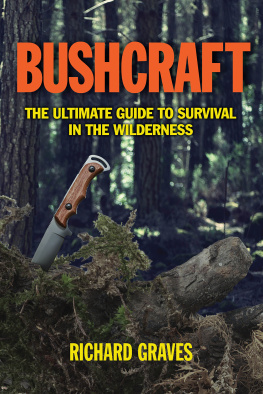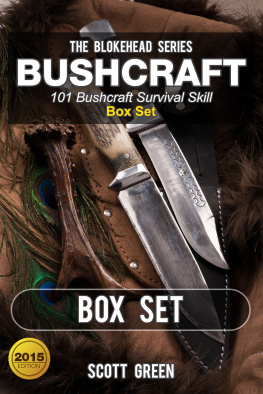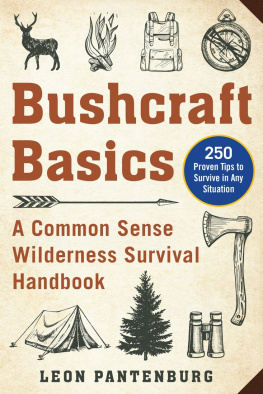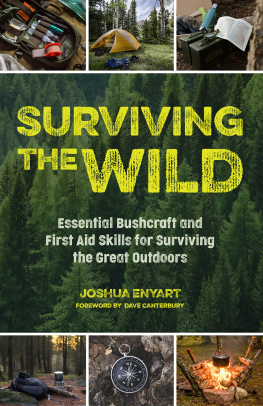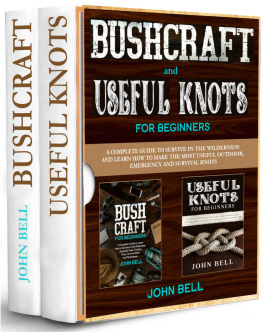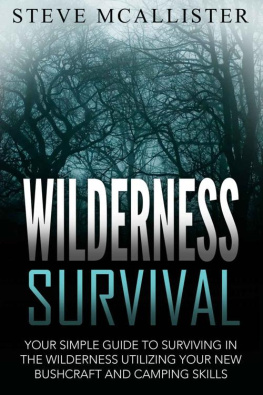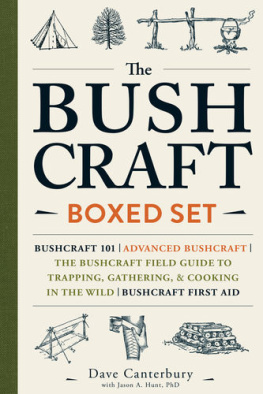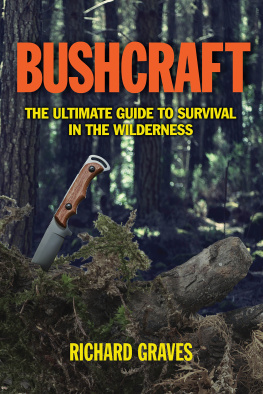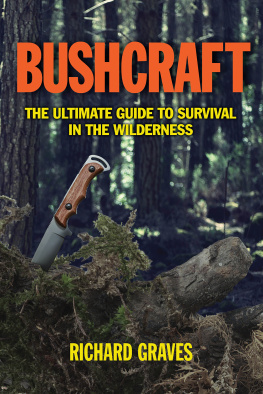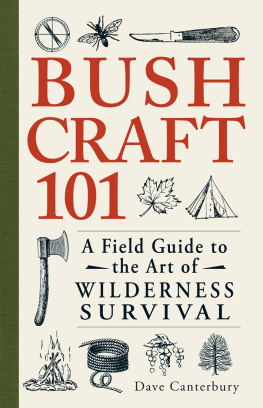BUSHCRAFT
BUSHCRAFT
THE ULTIMATE GUIDE TO SURVIVAL IN THE WILDERNESS
Richard Graves

Skyhorse Publishing
Copyright 1972,2013 by Richard Graves
All Rights Reserved. No part of this book may be reproduced in any manner without the express written consent of the publisher, except in the case of brief excerpts in critical reviews or articles. All inquiries should be addressed to Skyhorse Publishing, 307 West 36th Street, 11th Floor, New York, NY 10018.
Skyhorse Publishing books may be purchased in bulk at special discounts for sales promotion, corporate gifts, fund-raising, or educational purposes. Special editions can also be created to specifications. For details, contact the Special Sales Department, Skyhorse Publishing, 307 West 36th Street, 11th Floor, New York, NY 10018 or info@skyhorsepublishing.com.
Skyhorse and Skyhorse Publishing are registered trademarks of Skyhorse Publishing, Inc., a Delaware corporation.
www.skyhorsepublishing.com
10 987654321
Library of Congress Cataloging-in-Publication Data is available on file.
ISBN: 978-1-62087-361-8
Printed in the United States of America
CONTENTS
BUSHCRAFT
THE PRACTICE OF BUSHCRAFT shows many unexpected results. The five senses are sharpened, and consequently the joy of being alive is greater.
The individuals ability to adapt and improvise is developed to a remarkable degree. This in turn leads to increased self-confidence.
Self-confidence, and the ability to adapt to a changing environment and to overcome difficulties, is followed by a rapid improvement in the individuals daily work. This in turn leads to advancement and promotion.
Bushcraft, by developing adaptability, provides a broadening influence, a necessary counter to offset the narrowing influence of modern specialisation.
For this work of bushcraft all that is needed is a sharp cutting implement: knife, axe or machete. The last is the most useful. For the work, dead materials are most suitable. The practice of bushcraft conserves, and does not destroy, wild life.
R.H.G.
CHAPTER 1
ROPES AND CORDS
One of the first needs in Bushcraft is the ability to join poles or sticks. The only method available is by the use of lashings.
To use lashings however, it is necessary to have, find or make, materials for this purpose.
The ability to spin, or plait fibres into ropes or cords is one of the oldest of mans primitive skills. The method is simple, and follows precisely the same stages that are made use of by todays complicated machines.
The material from which to spin or plait ropes or cords is in abundance everywhere. Any fibrous material which has reasonable length, moderate strength and is flexible or pliable can be used. These are the three things to look for, and they can be found in many vines, grasses, barks, palms, and even in the hair of animals.
The breaking strains of handmade ropes and cords varies greatly with different materials, consequently it is essential that the rope or cord be tested for the purpose for which it will be used, before being actually put to use.
The uses to which these hand-made ropes and cords can be put, apart from lashing, is almost endless, and some few are included in this book.
THE MAKING OF ROPES AND CORDS
Almost any natural fibrous material can be spun into good serviceable rope or cord, and many materials which have a length of 12 to 24 inches, or more can be braided or plaited. Ropes of up to 3 and 4 inches diameter can be laid by four people, and breaking strains for bush-made rope of one inch diameter range from 100 lbs. to as high as 2,000 or 3,000 lbs.
BREAKING STRAINS
Taking a three lay rope of 1 inch diameter as standard, the following table of breaking strains may serve to give a fair idea of general strengths of various materials. For safety sake always regard the lowest figure as the breaking strain unless you know otherwise.
Green Grass ........ 100 lbs. to 250 lbs.
Bark Fibre ............ 500 lbs. to 1,500 lbs.
Palm Fibre ............ 650 lbs. to 2,000 lbs.
Sedges .......... 2,000 lbs. to 2,500 lbs.
Monkey Rope (Lianas) .... 560 lbs. to 700 lbs.
Lawyer Vine (Calamus) .... inch dia. 1,200 lbs.
Double the diameter quadruples the breaking strain.
Halve the diameter, and you reduce the breaking strain to one fourth.
PRINCIPLES OF ROPE MAKING MATERIALS
To discover whether a material is suitable for rope making it must have four qualities.
It must be reasonably long in the fibre.
It must have strength.
It must be pliable.
And it must have grip so that the fibres will bite onto one another.

There are three simple tests to find if any material is suitable.
First pull on a length of the material to test it for strength. The second test, to be applied if it has strength, is to twist it between the fingers and roll the fibres together; if it will stand this and not snap apart, tie a thumb knot in it, and gently tighten the knot. If the material does not cut upon itself, but allows the knot to be pulled taut, then it is suitable for rope making, providing that the material will bite together and is not smooth or slippery.
You will find these qualities in all sorts of plants, in ground vines, in most of the longer grasses, in some of the water reeds and rushes, in the inner barks of many trees and shrubs, and in the long hair or wool of many animals.

Some green freshly gathered materials may be stiff or unyielding. When this is the case try passing it through hot flames for a few moments. The heat treatment should cause the sap to burst through some of the cell structure, and the material thus becomes pliable.
Fibres for rope making may be obtained from many sources: Surface roots of many shrubs and trees have strong fibrous bark;
Dead inner bark of fallen branches of some species of trees and in the new growth of many trees such as willows;
In the fibrous material of many water and swamp growing plants and rushes;
In many species of grass and in many weeds;
In some sea weeds;
In fibrous material from leaves, stalks and trunks of many palms;
In many fibrous-leaved plants such as the aloes.
GATHERING AND PREPARATION OF MATERIALS
In some plants there may be a high content of vegetable gum and this can often be removed by soaking in water, or by boiling, or again, by drying the material and teasing it into thin strips.
Some of the materials have to be used green it any strength is required. The materials that should be green include the sedges, water rushes, grasses, and lianas.

Grasses, sedges and water rushes should be cut and never pulled. Cutting above ground level is harvesting, but pulling up the plant means its destruction.
It is advisable not to denude an area entirely but to work over a wide location and harvest the most suitable material, leaving some for seeding and further growth.
For the gathering of sedges and grasses, be particularly careful therefore to
Next page
